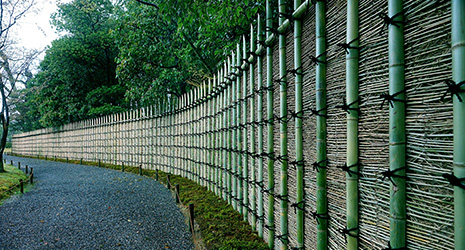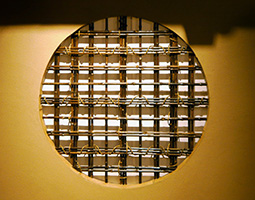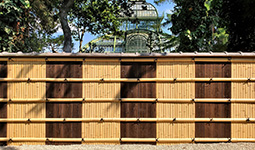August 2022
- English
- 日本語
Preserving the Traditions of Kyoto’s Bamboo

A bamboo fence installed at the Katsura Imperial Villa by Yokoyama Bamboo Products & Co 
An inuyarai bamboo fence resting against the wall of a traditional townhouse in Kyoto

A restaurant ceiling fitted with Kyo-meichiku split bamboo 
A bamboo lattice wall frame exposed as an interior design element 
A bamboo lighting fixture 
A bamboo fence in the Japanese garden at the Palace and Gardens of Schönbrunn, Vienna, Austria

In the historic city of Kyoto, bamboo has long been used as a construction material and for decorative purposes. One shop in Kyoto that specializes in manufacturing bamboo products and materials is also known for its development of new products while preserving traditional bamboo craft techniques.

Bamboo has long been used in Japan for everyday utensils, farming implements, construction materials and more. Kyoto, the nation’s capital for more than a millennium from the latter half of the 8th century, is the Japanese city with perhaps the deepest connection with bamboo. Bamboo has supported not only the lives of the people of Kyoto, but also their culture. For example, many Buddhist temples in Kyoto have carefully cultivated bamboo groves on their grounds. And bamboo is integral to the tea ceremony, which was popularized in Kyoto beginning in the 16th century, being used in the construction of tea houses and utensils such as tea whisks and tea scoops.

Founded in 1919, Yokoyama Bamboo Products & Co. is one of many Kyoto stores that continue to maintain and preserve Kyoto’s bamboo traditions. The store has worked on a number of well-known construction projects using bamboo in Japan. For example, there is a bamboo fence installed at the Katsura Imperial Villai, the garden of which is said to be one of Japan’s finest. The scale and beauty of this bamboo fence fascinates visitors. The store is also responsible for repairing and replacing items such as bamboo fences and roof gutters at the Konnichian, a tea house of the Urasenke school of the tea ceremony, which has been designated by the Japanese government as an Important Cultural Property.

“In Kyoto, where bamboo has been used as a material for construction and tool-making in various places, there are many bamboo forests, and people have been working hard to maintain and manage them, alongside which technologies and products related to bamboo have also developed,” says Yokoyama Yuki, the fourth-generation owner of Yokoyama Bamboo Products & Co. “Kyoto bamboo is supple and flexible, with a very clean surface. We grow bamboo and make a bamboo material using it called Kyo-meichiku.”

Kyo-meichiku, a traditional handicraft of Kyoto, is made by roasting the surface of the bamboo with fire to remove its oil, and then drying it in the sun. Shiny, beautiful and durable, the material is used in everyday life, such as for Kyoto’s distinctive bamboo fences called inuyarai, interior design materials, bamboo screens, and flower baskets. In addition to these conventional products, the store is also developing new products such as lighting fixtures, watches, cutlery, and even a stand for alcohol disinfectant using Kyo-meichiku. To further expand the use of bamboo as a construction material, the store developed the world’s first non-combustible bamboo material, called “Yokotake flameproof bamboo,” which it began developing in 2014. In Japan, the use of conventional bamboo materials for interior design has been restricted due to their flammability, but this new bamboo material can be used in places that were not possible before due to its high fire resistance, as certified by the Japanese Government (Fire and Disaster Management Agency of the Ministry of Internal Affairs and Communications). This bamboo material, which also has the beauty of Kyo-meichiku, has been used for the interiors of famous apparel brand stores, restaurants, hotels, and so forth both in Japan and overseas. “Protecting Japanese bamboo culture is my mission as the successor of Yokoyama Bamboo Products & Co.,” says Yokoyama. “The first step is to protect the old practices I’ve inherited. I believe that challenging myself to try new things based on that principle and sharing what I make will lead to the preservation of our traditions.”

Bamboo is a material that can add a Japanese-style flavor to buildings and products. Through Yokoyama’s ambitious efforts, more people will continue to discover the appeal of bamboo.
* Completed in its present form in the 17th century as a villa of the Hachijonomiya family. Often said to be the pinnacle of Japanese architecture and garden design.

